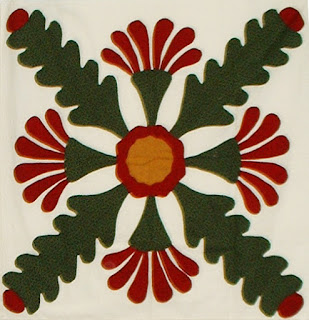Block identified in the Encyclopedia of Applique:
#19.31
[Print this and enlarge it for a pattern]
The magazine Ladies' Circle Patchwork Quilts
used to send Myron Miller and Carter Houk around
to museums to photograph quilts. What a gig! (as we used to say.)
One memorable design they photographed
was captioned Cochise County in the magazine.
Cochise County by Cora Viola Howell Slaughter (1860-1941
and Edith Stowe (?-1938),
Slaughter Ranch, Cochise County Arizona, c. 1890.
Collection of Arizona Historical Society.
See a large picture of this particular piece on
Lynn's blog from the last time AQSG met in Arizona
The quilt was pictured in the Arizona Project's book Grand Endeavors. They called it Feather Plume with Coxcombs in the book.
My friends and I were quite taken with the block. Nice four-way symmetry, fits the square gracefully and it's neither too complex to keep track of the pieces nor too hard to sew. Nancy Hornback wanted to know where it came from. Terry Thompson wanted to make a copy. I wanted to start a file. I found another example in an album quilt from about 1850.
Terry did a pattern for her Four Block Series.
This repro quilt block is by Lila Taylor.
Another example residing in Arizona,
recorded by the Arizona Project and the Quilt Index.
Is that a dark claret-colored red from the 1890-1920s?
And another from the Arizona Project.
All three of the Arizona examples look to be about 1890 by
the fabrics. This one features a claret red and a green that has turned khaki.
Perhaps this was a pattern with a regional popularity there after most
quilters had given up applique.
We collected photos of quilts in the design.
In my file I have lots of earlier examples from other states.
By Catherine Johnson Cover, Fayette County, Pennsylvania.
Three below from the Quilt Index.
This version
in the collection of the Tennessee History Center
looks a little earlier.
Rocky Mountain Quilt Museum collection.
Collection of the Hawks Inn Historical Museum in Waukesha, Wisconsin.
Well worn but looks 1840-1870 style.
Most have slight variations in the leaf (plume) or the floral
Most of the red floral on the north & south lines
had 6 petals, three going one way, three the other.
From Skinner Auctions---a little extra red on the leaf end.
From the International Quilt Study Center and Museum
#2012.013.0009
Thought to be from Ohio,
date-inscribed 1856, the earliest dated example I've found.
One of the few with the blocks on point.
Skinner Auction with 5 red petals.
From the Iowa Project with five petals.
From Cowan's Auctions.
The differences are subtle.
I could go on----and I will.
Source?
More color than most. Is this the same quilt at the top of the page?
From Vintage Blessings
Dated 1873 on a label, made by Mary Love Carwood.
Another example with four red petals
and some petals added to the end of the plume.
The original Cochise County had 4 red petals
Bonhams sold one that looks to be 20th century
almost exactly like Cochise County.
Same center, 4 petals, different color sashing
A terrific 20th-century example from Fourth Corner Quilts.
One in a sampler with curves converted to straight lines.
Another octagon in the center.
What to call it?
No mid-19th century name seems to have survived.
I've always liked "Cochise County" but I see
Susie at Cow Hollow Antiques
calls it a Mexican Rose.
She's sold this great crib quilt version (49" x 46").
And why not call it Mexican Rose? It does have a plume similar to the one
you see in the design called Mexican Rose.


































The Slaughter and Stowe Arizona quilt really seems to reflect the spare and spiky local plants, vs. the lusher east coast quilts. It feels western to me, so I prefer "Cochise County" too!
ReplyDeleteSee McCall's Quilting Nov/Dec 2010 for a Mexican Rose antique quilt with instructions.
ReplyDeleteWow, I never saw (or focused on) this block before and I love it. Several of your examples have their own individual charm as well. Thanks!
ReplyDeleteThe Slaughter & Stowe quilt is on exhibit this month at the Tempe History Museum, as part of an exhibit on Arizona Territorial-era quilts.
ReplyDeleteIn conjunction with the AQSG meeting there next week. A timely post on my part.
DeleteThis comment has been removed by a blog administrator.
ReplyDelete